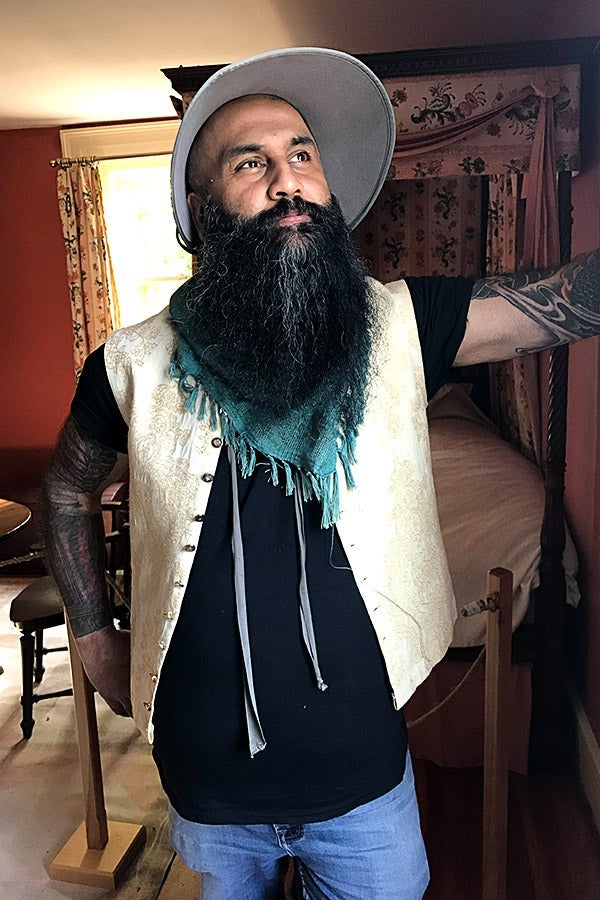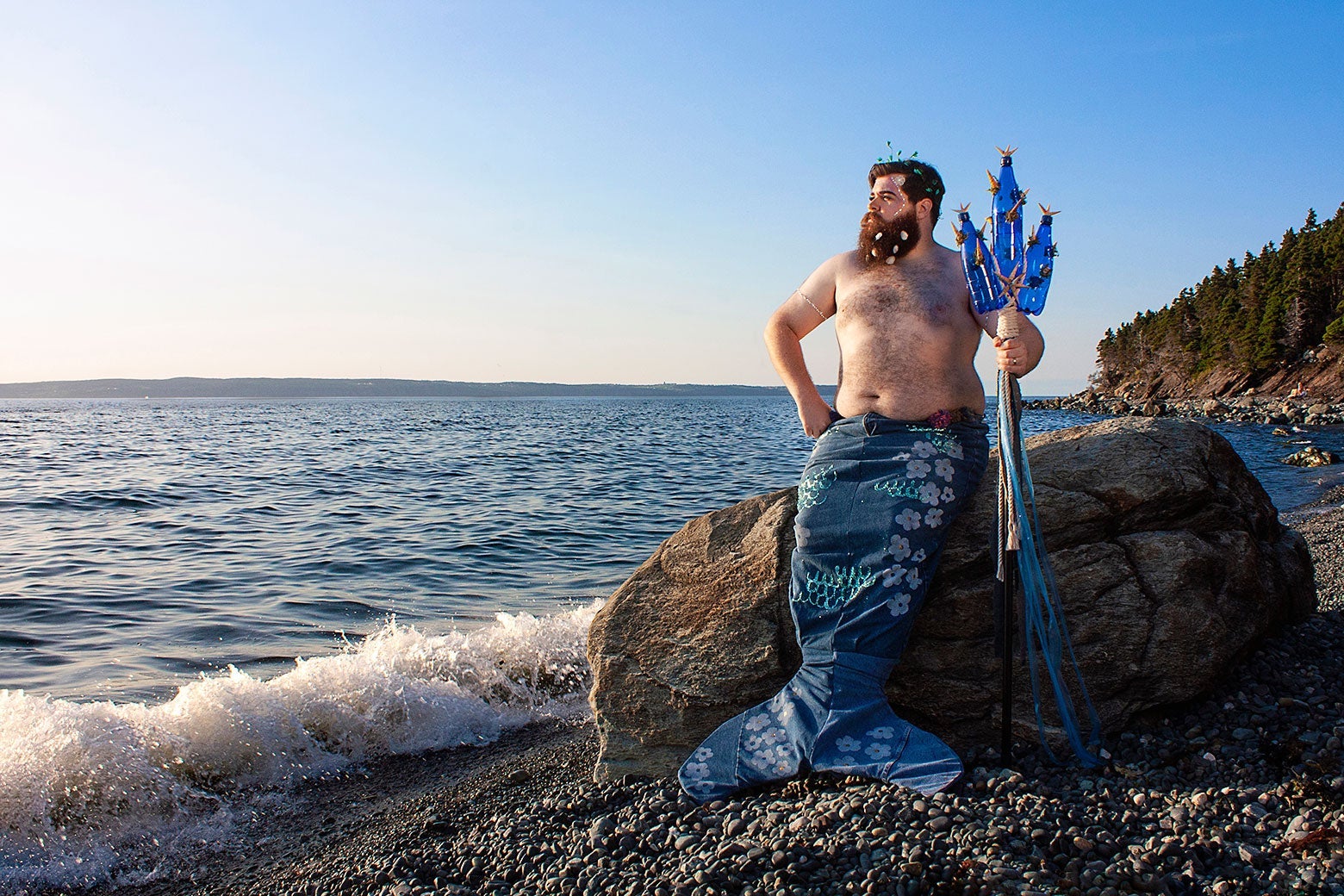The mermen began to appear in the summer of 2017, in St. John’s, Newfoundland, roughly midway between Montreal and Greenland. Sunning themselves on rocks by the harbor, or on the graffiti-strewn pylons of an abandoned waterfront fort, they caused quite a stir. One merman even ventured into a local tavern, where he splayed himself out atop the bar, puffing a long cigarette.
It turns out that the mermen did not suddenly emerge from the sea, but from the head of Hasan Hai, a Pakistani-Newfoundlander who works at a St. John’s tech start-up and as a bartender on the side. Several years ago, Hai, a gentle giant with tattoos, a shaved head, and a foot-long beard, started the Newfoundland and Labrador Beard and Mustache Club, a social organization, he told me, that has evolved into something akin to an enlightened Elks Lodge. “The intent is to promote healthy and non-traditional expressions of masculinity,” he said recently.
The mermen spotted around town of late are volunteers for the club’s annual fundraising effort, the Merb’y calendar (in Newfoundland-speak, b’y, roughly translated, means dude), now in its third year.
As skin-baring calendars go, the Merb’y version revealed significant demand for a chest-hair-and-pot-belly alternative to the busty-women-in-bikinis genre. The hope was to raise $1,000 for a local charity. The calendars ended up netting $300,000 in their first year, from buyers in 37 countries, funds that were donated to a sexual assault and domestic violence initiative that seeks to enlist and engage men in preventing such violence.

Since the first calendar debuted two years ago, the Beard and Mustache Club’s mission has rapidly expanded. It now runs fundraisers throughout the year and has partnered with Come From Away—the hit Broadway musical about a tiny Newfoundland town where 38 planes were forced to land on 9/11—to expand its reach. Hai and his Merb’ys have become media darlings in Canada. The CBC recently completed filming a documentary about the club. A St. John’s brewery now offers a Merby’s IPA. An all-ages Merb’ys cartoon (depicting an underwater world where a Merb’y feels free to be himself) and a line of Merb’y merch (stuffed Merb’ys, Merb’y action figures) are also in the works.
The Merb’ys impact has even extended into academia. The calendar was recently cited in a series of papers investigating the evolution of the mermaid archetype—often portrayed as an unattainable seductress—in an era of changing gender norms and “merculture” cosplay events, such as the annual MerMagic Con. The authors explore “how the merman is currently being reconsidered in ways that reflect and/or negotiate his phallic lack … by a group of hirsute and predominantly large bodied males in Newfoundland.” They posit that the demise of the fisheries from which Newfoundland men have historically derived their livelihoods underlies this shift in the region’s maritime culture. The Merby’s, the authors conclude, “have served to re-masculinise the merman.”
But for Hai, the calendars are a lighthearted way to start a conversation about a loaded topic. When the first calendar came out, the group pushed it as a tongue-in-cheek critique of “toxic masculinity,” but the term was like bait for men’s rights activists, who began clogging up the members’ social media feeds with spiteful chatter.
“The term toxic masculinity is very polarizing. A lot of people can’t look past those words, even though they are the people who need to hear the message,” Hai said. “They conflate it as an attack on men, as saying masculinity is inherently wrong, which is not the case—it’s just certain expressions of masculinity that are harmful. So we’ve changed our language.”
The group has few rules, though the website lays out guidelines for prospective Merby’s, including “Don’t be a dick, b’y” and “Inclusion is our jam.” It is one boy’s club in which women are definitely allowed: “It’s the beard inside that matters,” the website says.
Nikki Baldwin, the executive director of the St. John’s Planned Parenthood—the organization selected to receive the proceeds from the 2020 calendar—explained how some of those “expressions of masculinity” can be dangerous. “When men are taught to hold down their feelings, it can make their emotions come out in volatile ways. And in traditional gender roles, the subtext is that women are less valuable, subservient,” she said. “So when a man’s anger does bubble up, if they were not taught better ways to deal with their emotions, it can lead to gender-based violence, especially intimate partner violence.”
Certain modes of masculinity have also been tied to loneliness, depression, and high rates of male suicide. The Beard and Mustache Club is intended as a place for its members to bond and to express manhood in ways that might earn them ridicule in other settings. Members gather for barbecues, pub nights, and bonfires at the beach. And the yearly calendar production means getting together to sew merman tails and road-tripping around the island for photo shoots—which have been cathartic for many of the men involved.

“A lot of the models open up during the shoots, talking about their issues with mental illness or body image issues,” Hai said. “One fellow in the calendar hadn’t taken his shirt off in public since he was a child; he was embarrassed of his own body. It became a transformative experience for him.”
Jeff Hillyard was working as a forklift salesman when he saw a call on Facebook for guys willing to pose as mermen. He is now the vice president of the club. “The calendar project allows us to be whimsical and have fun and laugh. At the forklift dealership, the guys were like, ‘Hey man, don’t you know you look silly?’” Hillyard said. “That’s the whole idea. I still have the same masculine traits that I always had. They didn’t go anywhere. I just think it’s fun to put on a tail and throw some glitter in my beard and show a side of myself that I may not otherwise show.”
The Merby’s are widely known in the province, and the photos shoots can become a bit of a spectacle, with passerby attempting to take their own photos of the mermen. “Sometimes Hasan has to do crowd control,” said Courtney Wells, a graphic designer and the creative force behind the calendars. Newfoundland’s majestic fjords, rocky beaches, and historic ports and lighthouses serve as the backdrop for many of the photo shoots.
Wells recalled a young boy that showed up at one of the club’s events—“he liked mermaid tails and was getting bullied in school and told he was too girly”—who was made an “honorary Merb’y” on the spot, she said. “That little boy went away that day on top of the world. It’s incredibly refreshing to see very male-presenting, masculine men come out and say, I want to put on makeup, I want the frilliest tail you can find because I want to show my son or my daughter that there is more than one way to be a man.” The 2020 calendar includes gay and transgender men as well.
If Planet Merb’y can feel like one big PSA, Hai insisted it’s not about moral posturing so much as a product of real trials by fire—including his own. A father of three, Hai hit a low point in 2013 after the dissolution of his marriage. He’d become an angry person who “sometimes used harmful language” and was “extraordinarily defensive when my behavior was challenged by others,” traits he says helped lead to his divorce. Underneath those traits, he believes, was depression—a man unable to understand the reasons for his unhappiness and unwilling to step out of his “emotional silo.”
“I don’t feel like I was a pig or some terrible person, but there were all these small things that a lot of men don’t even realize we’re doing,” Hai said. He continues to discover blind spots: hogging the Merb’y spotlight, for example. The calendar was his idea, but its execution and success is largely a product of Wells’s graphic design talent and her dogged efforts to orchestrate photo shoots, costumes, printing, and shipping. In the deluge of media attention, Hai said it didn’t occur to him to share the stage.
“I feel like sometimes I get left out of interviews because I’m not the face of the Merby’s,” Wells told me.
Hai has recently made an effort to direct media requests and speaking invitations her way. “It shouldn’t be up to women or anyone who doesn’t have the stage to ask for it,” he said. “It’s incumbent on those of us in positions of power and privilege to give them those opportunities”—or to just get out of the way.
Update Jan. 24, 2020: This piece was updated to remove a reference to St. John’s as “a provincial fishing town.”
